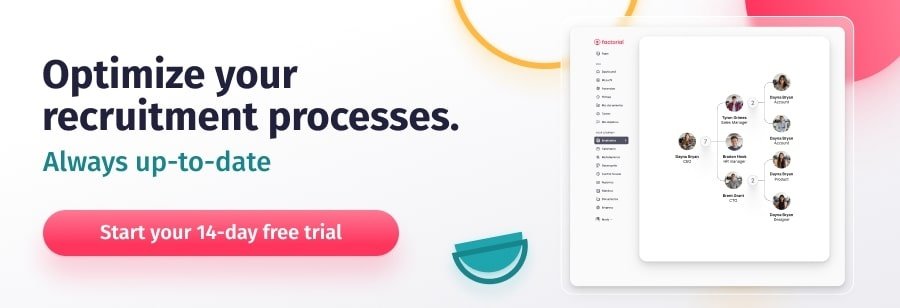In this article, we’ll explore the recruitment process when it comes to both internal and external recruitment.
With today’s rapid expansion and market growth, many new positions and opportunities are appearing. This past year has seen a boom in jobs, leading to a labor shortage. If companies want to successfully thrive and compete in this ever-expanding environment, they will have to pay careful attention to improving their recruitment process.
Sooner or later, managers will need to consider their recruitment strategies to fill up the needed positions. When facing this challenge, managers typically encounter a trade-off between promoting from within or to externally hire new employees to fill up the needed positions. Let’s examine both options and see which decision you should make to successfully thrive with today’s fierce market competition.
The Internal Recruitment Process: Benefits and Limitations
What is internal recruitment? The internal recruitment process refers to promoting employees from within the same organization to higher positions rather than bringing in new talent.
Pros of Internal Recruitment
- Saving money and time: One of the most notable advantages of this recruitment process is the lower costs. By promoting your pre-existing employees, you save all the money and time attached to searching, interviewing, and selecting suitable new candidates.
- Better fit to the organizational culture: One of the crucial aspects when hiring new employees is to see if they are a good fit for the organizational culture. However, when you promote employees from your company, they will be familiar with the culture and work environment. This makes them better equipped for an easier and smoother transition to their new positions.
- Less uncertainty: Another thing that you should consider when planning your recruitment process is the level of uncertainty attached to the whole process. The reason lies in the fact that there is a consistent fear of making a bad hiring decision. However, when you internally recruit, you will only promote skilled employees who showed considerable success in their old positions. This will substantially eliminate this uncertainty.
- Motivation: If you adopt a policy of promoting your employees based on their performance, many of them will be eager to work hard to win the promotion. This will increase the levels of motivation amongst your employees as they realize the space of career development within the organization. All in all, you will have highly motivated employees who are constantly improving their performance and more likely to stay longer in the organization.
Cons of Internal Recruitment
- Limited recruiting options: Promoting from within only considers your current employees. This will minimize the pool of applicants from which you can select a suitable employee, limiting your hiring options. As a result, you would face difficulty in finding the right applicant for the needed position.
- Need more training to fit their new positions: Your current employees might be very experienced in their current jobs. However, if you are planning to promote them, they will need further training to obtain the needed skills for their new tasks. Moreover, promoted employees leave vacancies in their old positions. So, you will need to hire external employees to fill these positions. This process might cost a tremendous amount of resources and time.
- Resentment and demotivation for unpromoted employees: Yes, promoting your employees improves their motivational levels. Still, this only affects the promoted employees. Those who see themselves worthy of promotions but were not favorable will get demotivated. This could lead to undesired group dynamics and an unsettling work environment that encourages jealousy and unhealthy competition among workers.
External Recruitment Process Outsourcing: Benefits and Limitations
So, what about the recruitment process outsourcing? The external recruitment process refers to the process of filling up vacancies in the organization by hiring new employees from the external labor market.
Pros of external recruitment
- New innovative ideas: As people stay longer in an organization, they begin adapting to each other’s ideas. Whereas this is very good for the group dynamics, as they tend to have fewer disputes and disagreements, it becomes difficult for such an echo chamber to generate unique ideas. Therefore, external recruitment gives you access to new fresh minds that will bring about innovative ideas from outside the organization. This will help freshen up your business in today’s competitive environment.
- More options for recruitment: As discussed earlier, one of the main disadvantages of the internal recruitment process is the limited number of candidates to new positions. External hiring, on the other hand, overcomes this issue as it introduces managers to a wider pool of applicants with a variety of skills from which they can choose. With exposure to many candidates, you can easily compare and select the best fit for the needed position.
- Better chance of hiring more experienced and skilled staff: Promoted employees usually need extensive training to be suitable for their new responsibilities. External recruitment process, on the contrary, ensures selecting those candidates who are more experienced, highly skilled, and generally a good fit for the needed positions. Nevertheless, they might require some orientation and basic training programs to introduce them to the work environment.
Cons of External Recruitment
- Higher costs: The external recruitment process involves a series of procedures to ensure the right selection of candidates. Often, this process consists of three main steps, which are searching, evaluating, and selecting. First, external hiring might involve job posting or reaching to third party agents to find potential applicants for the job. The second step involves background checks, interviewing, etc. the final step involves determining successful applicants and job offers. All of these steps require allocating a significant amount of the company’s resources, money, and time.
- Risk of bad hiring decision: As a recruiter, you will have to come up with the right recruitment process that ensures fairness and objectivity in evaluating every applicant. However, designing a 100% bias-free recruitment strategy is almost impossible. Hence, you will always be in danger of making bad hiring decisions.
Steps to Recruitment Process
Once you determine whether you will be following the phases in a recruitment process for internal recruitment or external, you can then move forward. Although internal recruitment may have fewer recruitment process steps, that doesn’t mean less attention should be placed towards candidate recruitment and selection and hiring. Here are 5 recruitment steps to get you started:
- Pay attention to, and identify the needs of the company and what you are looking for out of the process.
- Ensure you have a team of recruiters ready to rock and roll. They should be trained, briefed, and prepared to jump into the hiring process.
- Set the table. This means, preparing and putting out the job description on your site, and various hiring platforms.
- Screen the candidates. Using an applicant tracking system will save you a massive headache.
- Get ready to conduct the interviews. Make sure you know how to conduct an interview for the position you are hiring.
For more information, you’ll want to explore the full process of recruitment and selection.
Types of Recruiting: Internal vs. External – Conclusion
In the business world, recruitment processes are very challenging yet unavoidable. When making these choices, managers will face a trade-off between internal and external recruitment. On one hand, internal recruitment offers fewer costs, more stability, and safer transitions. External recruitment strategies, on the other hand, offer a wider selection pool.
Also, you get to choose from more innovative and experienced workers who will freshen up your business. In order to determine the best strategy for your business, you must first understand your organization’s type. Companies have different circumstances, needs, and problems and the best is to have a good balance that matches your organization’s demands.
Find out how HS software can improve your recruitment process. An applicant tracking system can streamline your hiring process from start to finish. Try a 14-day free trial of our recruitment software.



Thanks admin for sharing this informative post.
Thank you so much, i get some needed assistance. I will keep in touch with your platform now.
I will do so next time. for now thank you for your great help.